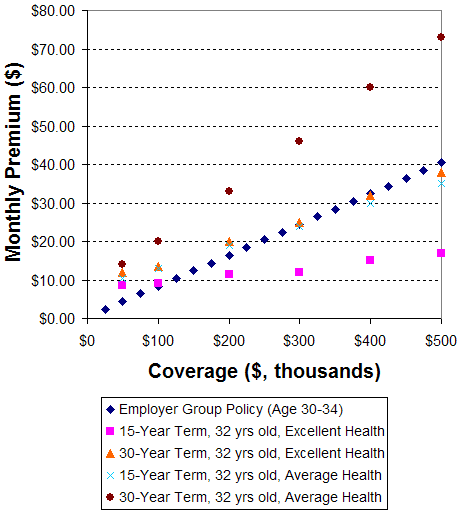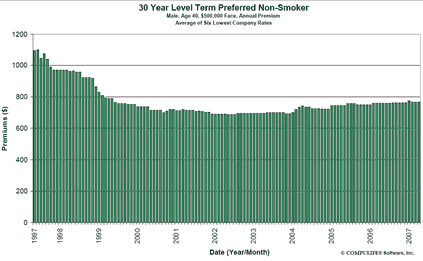I’m not an insurance or benefits expert, but while looking at life insurance I wanted to compare the coverage available from my employer vs. what I could buy on my own. As with most things insurance-related, there are big variations in group life insurance coverage, so I can only speak to what I have for the most part. We get a credit each paycheck for which we can spend on health, dental, life, and disability insurances.
Maximum Coverage
For my plan, I can only get up to $500,000 of coverage for myself and partner. So if I want more, my only choice would be to look privately for equivalent term life insurance.
Ability To Find Coverage
The best thing about group insurance from work is that your risk is spread across a big pool of people, so it should be easier to be granted coverage. But many workplaces still require you provide “evidence of insurability” once you increase your coverage limit past a certain amount. This may involve a simple questionnaire, or it could require a doctor exam and bloodwork. It seems unclear exactly how “healthy” you have to be in order to qualify for increased group coverage, but I’m guessing it would preclude major pre-existing conditions like cancer or heart disease. The limit where they start checking can also vary from $5,000 to $500,000.
Portability of Insurance
When you qualify for and buy a level term life insurance policy, you are guaranteed coverage for the length of that term (10, 20, 30 years, etc.). But if you rely on your employer’s group life insurance, usually the coverage stops when you leave the job. It’s almost like a 1-year term policy. My concern is, if you have you leave your job because you are seriously disabled, then you might end up both uncovered and unable to find new insurance.
However, looking around there might be some flexibility in certain plans. For one, you might have a “Waiver of Premium” benefit that continues the insurance protection through age 65 with no further premium payments should you become disabled. Or the policy may allow you to “continue coverage through an individual term policy without evidence of insurability as long as you continue to pay premiums”. Would this still be at the group insurance rates (minus employer subsidies)? A lot of this stuff seems to be left out of my Open Enrollment Guide, so I suppose an e-mail to the correct Human Resource person would be in order.
Cost
Many people get a certain amount of “free” life insurance from work, with the option to buy more. I think anything over $50,000 of coverage is paid with after-tax money, so I plotted out the monthly cost of my group plan vs. coverage levels below. I then went to Term4Sale and found the average of the top 5 quotes for both 15 and 30-year term insurance policy (rated A+ or better), for both the best tier of health (Preferred Plus) and the lowest allowable (Standard).

If you are youngish and in good health, even a long 30-year term policy is comparable to the group rates. Even if you are in average health, the cost of my employer group insurance is comparable to the premium on a 15-year term policy.
Summary
Again, this is only based on my plan, although I found my wife’s numbers to be similar. If you are lucky to have no-questions-asked insurance with high limits and you are in below-average health, it might be good to use your group plan. But if you are looking for extra coverage for a guaranteed period of time and are at least relatively healthy, it’s probably just as cheap if not cheaper to go with an individual plan. If you are an older worker, things may tilt back in favor to group life, but I haven’t run those numbers. In any case, it’s worth a comparison before your next Open Enrollment period.
We used to just buy some extra coverage from work due to the convenience factor, but why pay more when I could both save money and have a better, portable plan?

 I recently received a nice greenish pamphlet from the government, my Social Security Statement! I thought it would tell me how much to expect from them in retirement… instead it just says is that I haven’t accumulated enough work credits to get Social Security benefits. Gee, thanks… *toss*. But wait, a few recent events have shown me other ways that it can be useful.
I recently received a nice greenish pamphlet from the government, my Social Security Statement! I thought it would tell me how much to expect from them in retirement… instead it just says is that I haven’t accumulated enough work credits to get Social Security benefits. Gee, thanks… *toss*. But wait, a few recent events have shown me other ways that it can be useful.  I’ve been noticing that multiple banks like Washington Mutual, Bank of America, and other banks have been offering me “free” Accidental Death & Dismemberment (AD&D) Insurance. Usually I get around $1,000 to $3,000 of complimentary coverage, just for being a valued customer. Awww, how thoughtful! At first glance, it sounds pretty good. That could cover a few funeral expenses in case I decide to go sky-diving again.
I’ve been noticing that multiple banks like Washington Mutual, Bank of America, and other banks have been offering me “free” Accidental Death & Dismemberment (AD&D) Insurance. Usually I get around $1,000 to $3,000 of complimentary coverage, just for being a valued customer. Awww, how thoughtful! At first glance, it sounds pretty good. That could cover a few funeral expenses in case I decide to go sky-diving again.

 If you’re like me, you don’t rent cars very much outside of work. But when I do, I’m always of mixed emotion when it comes down to the inevitable question: Do you want to buy the Loss Damage Waiver (LDW)? It costs around $20/day, but it basically absolves you of any liability if the car becomes dented, breaks down, gets scratched, blown up, or whatever.
If you’re like me, you don’t rent cars very much outside of work. But when I do, I’m always of mixed emotion when it comes down to the inevitable question: Do you want to buy the Loss Damage Waiver (LDW)? It costs around $20/day, but it basically absolves you of any liability if the car becomes dented, breaks down, gets scratched, blown up, or whatever.  For a while now, online payment service
For a while now, online payment service  Starting a new job means signing up for benefits. In terms of health insurance, this has usually boiled down to choosing either an HMO or PPO plan for us. I still have never been offered the option of a High Deductible Health Plan (HDHP) with a
Starting a new job means signing up for benefits. In terms of health insurance, this has usually boiled down to choosing either an HMO or PPO plan for us. I still have never been offered the option of a High Deductible Health Plan (HDHP) with a  Unless you have unlimited ATM access to the Bank of Mom and Dad, most of us keep some money around for the unexpected. I haven’t been worrying about this much, as we have over $80,000 in cash split between our savings accounts at Washington Mutual (5% APY) and
Unless you have unlimited ATM access to the Bank of Mom and Dad, most of us keep some money around for the unexpected. I haven’t been worrying about this much, as we have over $80,000 in cash split between our savings accounts at Washington Mutual (5% APY) and  The Best Credit Card Bonus Offers – 2025
The Best Credit Card Bonus Offers – 2025 Big List of Free Stocks from Brokerage Apps
Big List of Free Stocks from Brokerage Apps Best Interest Rates on Cash - 2025
Best Interest Rates on Cash - 2025 Free Credit Scores x 3 + Free Credit Monitoring
Free Credit Scores x 3 + Free Credit Monitoring Best No Fee 0% APR Balance Transfer Offers
Best No Fee 0% APR Balance Transfer Offers Little-Known Cellular Data Plans That Can Save Big Money
Little-Known Cellular Data Plans That Can Save Big Money How To Haggle Your Cable or Direct TV Bill
How To Haggle Your Cable or Direct TV Bill Big List of Free Consumer Data Reports (Credit, Rent, Work)
Big List of Free Consumer Data Reports (Credit, Rent, Work)